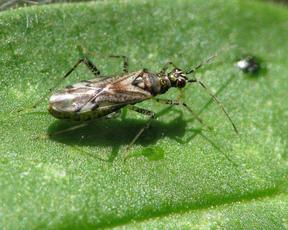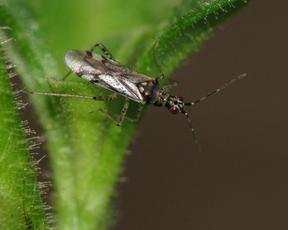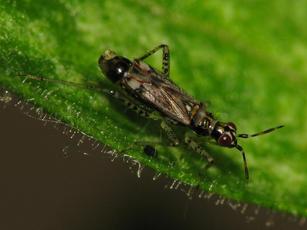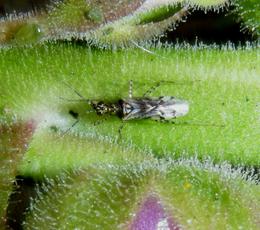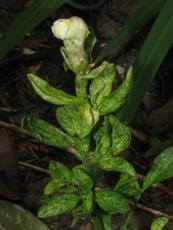Dicyphus escalerae
The rather coarse black pubescence arising from black spots on the dorsal surface helps to distinguish it from other UK Dicyphus species.
Detailed examination of the specimen is needed to identify the species.
On Snap-dragon (Antirrhinum majus).
UK sightings have fallen between March and November so far, but adults and nymphs overwinter so it can be seen outside this range.
This bug seems to feed exclusively on Antirrhinums, using all parts of the plant, especially the flower spikes. It causes obvious feeding damage of white or yellow flecks when numbers are sufficient. Nymphs have only been seen on Antirrhinum majus but the adults show some dispersal to form new colonies and so may also be encountered elsewhere.
This Mirid bug has been spreading out across Europe from its original Western-Mediterranean range, probably with the help of cultivated Snap-dragons moving through the horticultural trade. It was first seen in the UK in 2007 and has already been found at numerous different sites across the country.
Still infrequent in Leicestershire and Rutland.
Leicestershire & Rutland Map
Enter a town or village to see local records
MAP KEY:
Yellow squares = NBN records (all known data)
Coloured circles = NatureSpot records: 2020+ | 2015-2019 | pre-2015
UK Map
Species profile
- Species group:
- Bugs
- Kingdom:
- Animalia
- Order:
- Hemiptera
- Family:
- Miridae
- Records on NatureSpot:
- 6
- First record:
- 13/07/2008 (Gould, David)
- Last record:
- 21/06/2022 (Stevens, Margaret)
Total records by month
% of records within its species group
10km squares with records
The latest images and records displayed below include those awaiting verification checks so we cannot guarantee that every identification is correct. Once accepted, the record displays a green tick.
In the Latest Records section, click on the header to sort A-Z, and again to sort Z-A. Use the header boxes to filter the list.


